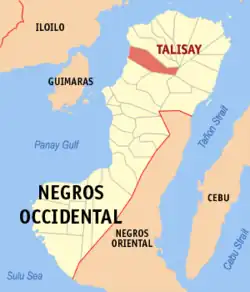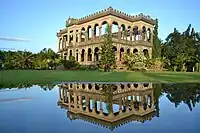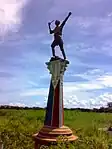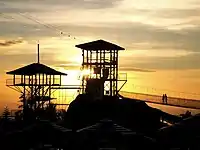Talisay, Negros Occidental
Talisay, officially the City of Talisay (Hiligaynon: Dakbanwa sang Talisay; Cebuano: Dakbayan sa Talisay; Filipino: Lungsod ng Talisay), is a 4th class component city in the province of Negros Occidental, Philippines. According to the 2020 census, it has a population of 108,909 people.[3]
Talisay
Minuluan | |
|---|---|
| City of Talisay | |
 View of The Ruins of the Mariano Ledesma Lacson Mansion, Talisay City at dusk | |
 Flag | |
 Map of Negros Occidental with Talisay highlighted | |
OpenStreetMap | |
.svg.png.webp) Talisay Location within the Philippines | |
| Coordinates: 10°44′N 122°58′E | |
| Country | Philippines |
| Region | Western Visayas |
| Province | Negros Occidental |
| District | 3rd district |
| Founded | 1788 |
| Chartered | September 29, 1850 |
| Cityhood | February 11, 1998 |
| Barangays | 27 (see Barangays) |
| Government | |
| • Type | Sangguniang Panlungsod |
| • Mayor | Nilo Jesus Antonio Neil E. Lizares III |
| • Vice Mayor | Jose Nicolas V. Jalandoni III |
| • Representative | Jose Francisco B. Benitez |
| • City Council | Members |
| • Electorate | 66,445 voters (2022) |
| Area | |
| • Total | 201.18 km2 (77.68 sq mi) |
| Elevation | 176 m (577 ft) |
| Highest elevation | 2,413 m (7,917 ft) |
| Lowest elevation | 0 m (0 ft) |
| Population (2020 census)[3] | |
| • Total | 108,909 |
| • Density | 540/km2 (1,400/sq mi) |
| • Households | 25,771 |
| Economy | |
| • Income class | 4th city income class |
| • Poverty incidence | 3.52 |
| • Revenue | ₱ 819.4 million (2020) |
| • Assets | ₱ 2,271 million (2020) |
| • Expenditure | ₱ 734 million (2020) |
| • Liabilities | ₱ 675.7 million (2020) |
| Service provider | |
| • Electricity | Central Negros Electric Cooperative (CENECO) |
| Time zone | UTC+8 (PST) |
| ZIP code | 6115 |
| PSGC | |
| IDD : area code | +63 (0)34 |
| Native languages | Hiligaynon Tagalog |
| Website | www |
It is part of the metropolitan area called Metro Bacolod, which includes its neighbors Silay to the north and Bacolod to the south.[5] It has a total land area of 20,118 hectares (49,710 acres).
Talisay is often confused with another Visayas city also named Talisay, which is a component city in Cebu.
History
The Negritos, natives who led nomadic lives at the foot of scenic North Negros mountain ranges, originally inhabited Talisay. In 1788, families of Malay descent settled in the pristine part of Negros Island and named it Minuluan. Unknown to many, the sugar industry in province has its very roots in Talisay. The enterprising Recollect priest led by Fray Fernando Cuenca, spurred the economic development of this once sleepy Sitio through the planting of sugarcane in vast tracts of land we call ‘haciendas’. still part of the City of smiles
The seedlings, brought from Spain, thrived well in the rich, loamy soil. Fray Cuenca improved sugar production of the crude wooden mills with the invention of ‘Molino de Agua’. The Spanish colonizers became guardians of our economic, socio-political and spiritual lives, and with more of the Minuluan population embracing the Catholic faith, the Sitio was decreed a town on September 10, 1850, with San Nicolas de Tolentino as its patron saint. It was renamed Talisay after the tree that grew in abundance along the mouth of the Matab-ang River.
To accommodate the growing population, three more barrios were established – Dos Hermanas and San Fernando in the northern part and Concepcion in the South.
At the turn of the century, Talisay became a significant player in revolt against Spain through the leadership of General Aniceto Lacson. The wily general and erstwhile Katipunero of the North teamed up with General Araneta from the South during the victorious Cinco de Noviembre uprising in 1898 that saw the Spaniards capitulating without bloodshed. The intervening years saw Talisay growing and methamorphosing into the budding city that is today-full of promise and potential.
Cityhood
On February 11, 1998, by virtue of Republic Act No. 8489, Talisay through the effort of its local official led by the Mayor Amelo Lizares was finally elevated into a city.[6]
Geography
Talisay City is 7 kilometres (4.3 mi) north of Bacolod, facing the Bacolod–Silay Access Road in the east.
Barangays
Talisay City is politically subdivided into 27 barangays. Each barangay consists of puroks and some have sitios.
- Bubog
- Cabatangan
- Zone 4-A (Poblacion)
- Zone 4 (Poblacion)
- Concepcion
- Dos Hermanas
- Efigenio Lizares
- Zone 7 (Poblacion)
- Zone 14-B (Poblacion)
- Zone 12-A (Poblacion)
- Zone 10 (Poblacion)
- Zone 5 (Poblacion)
- Zone 16 (Poblacion)
- Matab-ang
- Zone 9 (Poblacion)
- Zone 6 (Poblacion)
- Zone 14 (Poblacion)
- San Fernando
- Zone 15 (Poblacion)
- Zone 14-A (Poblacion)
- Zone 11 (Poblacion)o
- Zone 8 (Poblacion)
- Zone 12 (Poblacion)
- Zone 1 (Poblacion)
- Zone 2 (Poblacion)
- Zone 3 (Poblacion)
- Katilingban
Climate
| Climate data for Talisay | |||||||||||||
|---|---|---|---|---|---|---|---|---|---|---|---|---|---|
| Month | Jan | Feb | Mar | Apr | May | Jun | Jul | Aug | Sep | Oct | Nov | Dec | Year |
| Average high °C (°F) | 28 (82) |
29 (84) |
30 (86) |
32 (90) |
31 (88) |
30 (86) |
29 (84) |
30 (86) |
29 (84) |
29 (84) |
29 (84) |
28 (82) |
30 (85) |
| Average low °C (°F) | 23 (73) |
23 (73) |
23 (73) |
24 (75) |
25 (77) |
25 (77) |
25 (77) |
25 (77) |
25 (77) |
24 (75) |
24 (75) |
24 (75) |
24 (75) |
| Average precipitation mm (inches) | 120 (4.7) |
87 (3.4) |
95 (3.7) |
97 (3.8) |
187 (7.4) |
263 (10.4) |
251 (9.9) |
220 (8.7) |
227 (8.9) |
268 (10.6) |
220 (8.7) |
158 (6.2) |
2,193 (86.4) |
| Average rainy days | 16.1 | 12.6 | 15.4 | 16.8 | 25.8 | 28.4 | 29.1 | 27.9 | 27.7 | 28.5 | 23.9 | 18.4 | 270.6 |
| Source: Meteoblue[7] | |||||||||||||
Demographics
| Year | Pop. | ±% p.a. |
|---|---|---|
| 1903 | 14,548 | — |
| 1918 | 14,165 | −0.18% |
| 1939 | 40,547 | +5.14% |
| 1948 | 43,610 | +0.81% |
| 1960 | 46,308 | +0.50% |
| 1970 | 45,084 | −0.27% |
| 1975 | 48,518 | +1.48% |
| 1980 | 53,624 | +2.02% |
| 1990 | 63,260 | +1.67% |
| 1995 | 68,401 | +1.47% |
| 2000 | 79,146 | +3.18% |
| 2007 | 96,444 | +2.76% |
| 2010 | 97,571 | +0.42% |
| 2015 | 102,214 | +0.89% |
| 2020 | 108,909 | +1.26% |
| Source: Philippine Statistics Authority[8][9][10][11] | ||
Economy
Business process outsourcing
In 2016, business process outsourcing (BPO) company iQor opens its call/contact center in Talisay, the first BPO company in the city.[19]
Education
Talisay is also known for its 2 major tertiary institutions: The Technological University of the Philippines – Visayas and Carlos Hilado Memorial State University, Main Campus. Talisay also has 2 private schools that offer K-12 Education which are the: Colegio San Nicolas De Tolentino-Recoletos and Notre Dame-Talisay Schools.
Places of interest
 The Ruins, an old mansion located in the city is a known tourist attraction
The Ruins, an old mansion located in the city is a known tourist attraction Statue of Andres Bonifacio
Statue of Andres Bonifacio The District - North Point at Ayala North Point, is the major shopping place in the city
The District - North Point at Ayala North Point, is the major shopping place in the city Campuestohan Highland Resort in Sitio Campuestohan, Barangay Cabatangan
Campuestohan Highland Resort in Sitio Campuestohan, Barangay Cabatangan Aniceto Lacson House
Aniceto Lacson House
See also
References
- City of Talisay | (DILG)
- "2015 Census of Population, Report No. 3 – Population, Land Area, and Population Density" (PDF). Philippine Statistics Authority. Quezon City, Philippines. August 2016. ISSN 0117-1453. Archived (PDF) from the original on May 25, 2021. Retrieved July 16, 2021.
- Census of Population (2020). "Region VI (Western Visayas)". Total Population by Province, City, Municipality and Barangay. Philippine Statistics Authority. Retrieved July 8, 2021.
- "PSA Releases the 2018 Municipal and City Level Poverty Estimates". Philippine Statistics Authority. December 15, 2021. Retrieved January 22, 2022.
- "Building Globally Competitive Metro Areas in the Philippines" (PDF). Archived from the original (PDF) on July 5, 2010. Retrieved June 16, 2010.
- "Talisay City". Negros Occidental Provincial Government. Retrieved July 10, 2014.
- "Talisay: Average Temperatures and Rainfall". Meteoblue. Retrieved May 7, 2020.
- Census of Population (2015). "Region VI (Western Visayas)". Total Population by Province, City, Municipality and Barangay. Philippine Statistics Authority. Retrieved June 20, 2016.
- Census of Population and Housing (2010). "Region VI (Western Visayas)" (PDF). Total Population by Province, City, Municipality and Barangay. National Statistics Office. Retrieved June 29, 2016.
- Censuses of Population (1903–2007). "Region VI (Western Visayas)". Table 1. Population Enumerated in Various Censuses by Province/Highly Urbanized City: 1903 to 2007. National Statistics Office.
- "Province of". Municipality Population Data. Local Water Utilities Administration Research Division. Retrieved December 17, 2016.
- "Poverty incidence (PI):". Philippine Statistics Authority. Retrieved December 28, 2020.
- "Estimation of Local Poverty in the Philippines" (PDF). Philippine Statistics Authority. November 29, 2005.
- "2003 City and Municipal Level Poverty Estimates" (PDF). Philippine Statistics Authority. March 23, 2009.
- "City and Municipal Level Poverty Estimates; 2006 and 2009" (PDF). Philippine Statistics Authority. August 3, 2012.
- "2012 Municipal and City Level Poverty Estimates" (PDF). Philippine Statistics Authority. May 31, 2016.
- "Municipal and City Level Small Area Poverty Estimates; 2009, 2012 and 2015". Philippine Statistics Authority. July 10, 2019.
- "PSA Releases the 2018 Municipal and City Level Poverty Estimates". Philippine Statistics Authority. December 15, 2021. Retrieved January 22, 2022.
- "MassKara 2016: Get Hired And Celebrate With iQor | SignedEvents.com". Archived from the original on October 20, 2016.